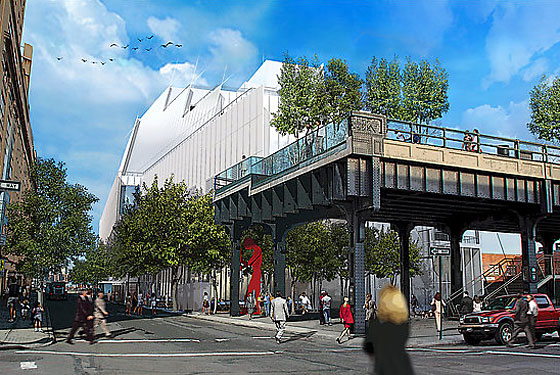
A sort of harmonic convergence is happening right now at the Whitney Museum of American Art. From top to bottom, the Whitney looks as good as it has in years. Every show tells you things you didn’t know you needed to know, makes old art look new, or allows new art to shine. The Christian Marclay exhibition, which opens today on the fourth floor, transforms this artist of sound and music into a post-Cagian genius before your eyes and ears. (The other night I watched in amazement as Sonic Youth’s Lee Ranaldo and others musically interpreted a Marclay video.) The third-floor Charles Burchfield survey, brilliantly curated by artist Robert Gober, places an important forgotten American artist in center aesthetic court, and assures us that he won’t be absent for some time. The group show on the second floor demonstrates how artists have used performance and process to insinuate the body into art, effectively telling us that no art is really “anti-art.” There’s more, all good, on the other floors.
Now, after 25 years of trying to build extensions to its cement fortress on Madison Avenue, the Whitney is going to do something very bold and scary — something that, in the light of these excellent shows, it seems ready to do. The Whitney is going to replicate itself. A year from now, it will break ground at a second location in the meatpacking district — while also keeping its cramped 32,000-square-foot uptown building, where it has been difficult to mount comprehensive retrospectives, or to show more than 150 pieces at a time from its superb collection of over 18,000 works.
The new building will not be perfect. And there will be unforeseen problems that may get top people fired. The statistics are already a little alarming: While the new space is billed as a hefty-sounding 195,000 square feet, only around 50,000 square feet will be devoted to the indoor exhibition of art. This increase, while welcome, still feels like way too little — especially given the enormous risks being taken by increasing the museum’s overall running costs.
If I were on the Whitney’s planning committee I’d trust the curators to curate, even if many of their shows would be infuriating. I’d harp on one thing: building enough interior space to permanently display the permanent collection. The Whitney must learn from the Museum of Modern Art’s mistakes. Even after spending over $750 million dollars on their expansion, MoMA neglected to reserve enough room for the greatest collection of modern art in the world. The result borders on tragic. The Whitney plans to build nice-sounding things downtown — outdoor sculpture gardens, roof decks, classrooms, seminar rooms, a research library, an auditorium, a study center, a café, and a bookstore. But none of that will matter if it fails to build enough space for art — and 50,000 square feet doesn’t sound like enough.
As philistine as it sounds, I don’t think the art world cares how the outside of the new Whitney looks. Let starchitect Renzo Piano make whatever kind of artsy statement he needs to make. The art world only cares that the building accommodate the museum’s magnificent collection, and that this space be congenial to art. The Whitney is in the absolutely unique position to tell the largely untold story of American art. Think of their pre-1950 collection alone. It’s impossible to have too many Marsden Hartleys on view (there are no Hartleys on permanent view at the Whitney, MoMA, or the Guggenheim right now). There should be rooms of Alice Neel, Georgia O’Keefe, Lee Bontecou, Arthur Dove, Stuart Davis, Arshile Gorky, and Paul Cadmus. Ample installations of work by Diane Arbus, Ken Price, George Ohr, Florine Stettheimer, Maya Deren, Horace Pippin, and Henry Darger would let us experience some of the greatest visionaries who ever lived. A room of Martin Ramirez would establish that he was maybe the greatest so-called “outsider” artist to ever work in our country. A room devoted to Russ Meyer’s nudie photographs (perhaps installed by John Waters) would be a bonkers bookend to a Warhol room. The museum should play continuous loops of Fred Astaire and Ginger Rodgers dancing cheek-to-cheek in Top Hat; a mad choreographed sequence from Busby Berkeley; Steamboat Willie; and Martha Graham being a banshee. Having all of this on permanent view would change the way we look at American art — and the way American art looks.
Many say what the Whitney is doing is reckless and wrong: that the costs will sky rocket, the audience will be confused by the two locations and attendance will plummet, that the meatpacking district will become ever more like a zoo. I disagree. If the Whitney didn’t do this, it would be fated to become little more than a glorified kunsthalle, a fancy space for temporary exhibitions. Their current thinking is encouraging: spread the permanent collection and new shows across both spaces, so that downtown won’t just be for new art, and the uptown won’t become a sleepy spot for old art. The Whitney is doing what Cortez did after he landed in the New World, gathered his troops on the shore, and set fire to the ships. Cortez was saying, “We’re never going back.” Now that the Whitney has divested itself of its adjoining brownstones, its board has unanimously signed-off on the downtown location, and the city has given the final go-ahead, the Whitney will never build an extension of its uptown building. With its current team, the museum seems ready to make this new home for art and art history. If it builds enough space for the ongoing display of the permanent collection, all will be well. If not, an extraordinary opportunity will have been squandered.

